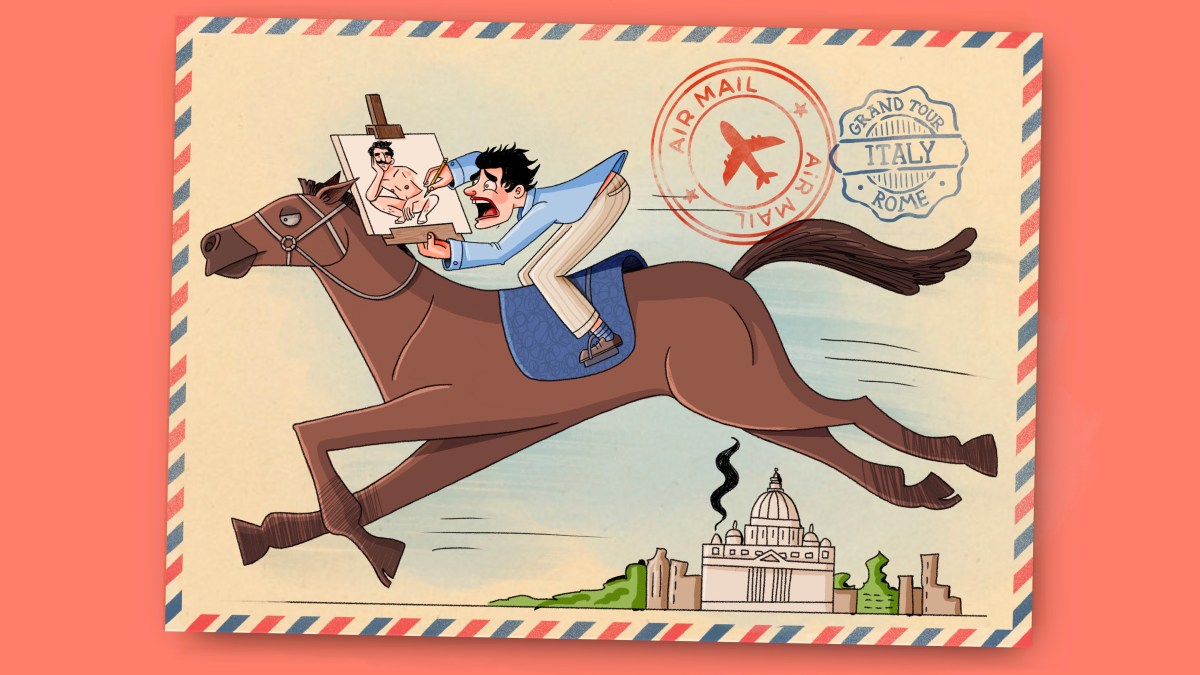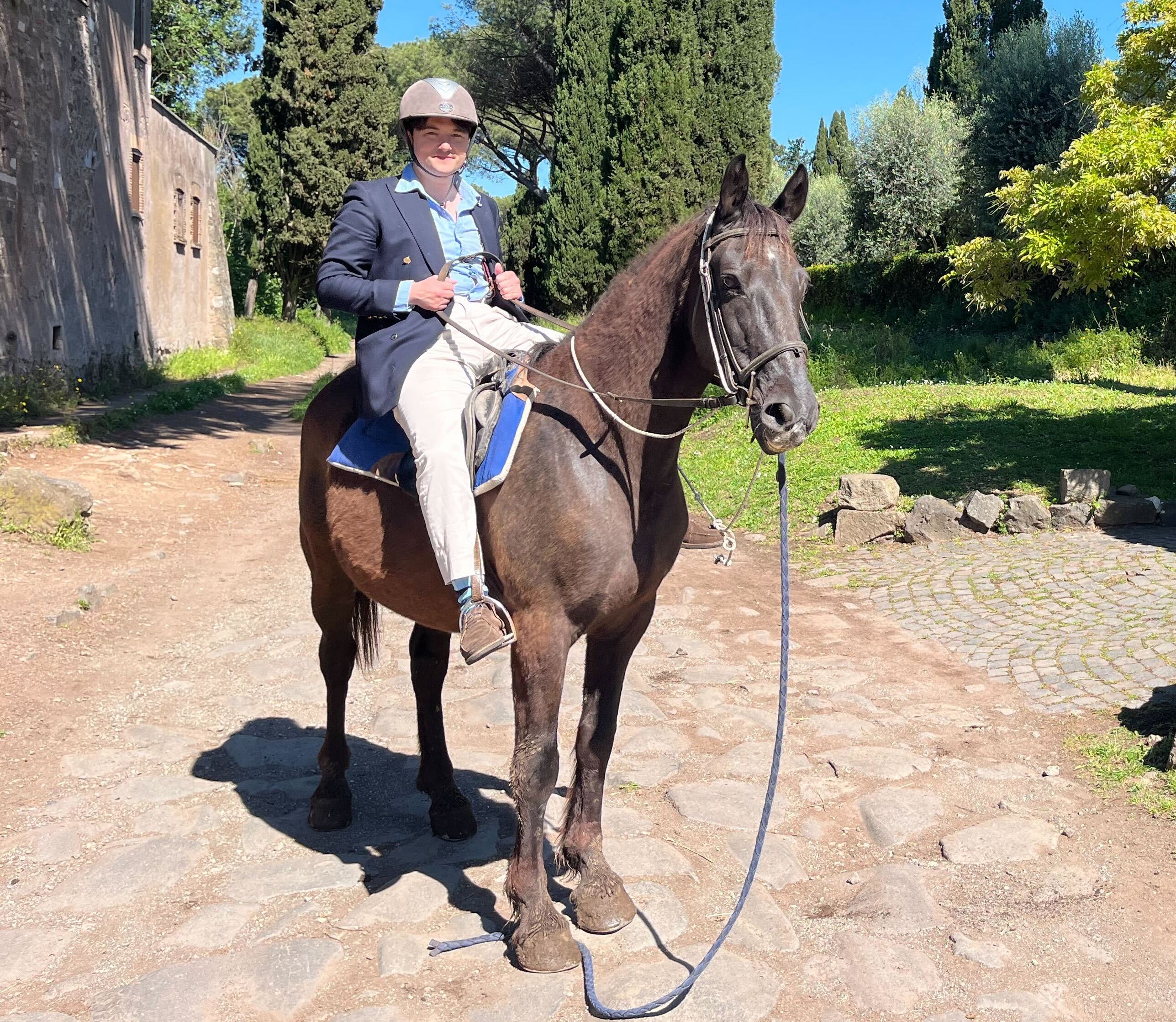I wake half-dressed and groaning in a palazzo in Rome, feeling so ruined that I might need Unesco protection. My eyes are bloodshot, my shirt stained and I’ve no memory of last night, though I’m still clutching an empty bottle of Umbrian wine. It’s plugged with a roll of parchment, which I unroll to reveal a sketch of a naked man in an alarming pose. My heart sinks as my memory mends.
The day before I’d arrived from Switzerland and checked into the Villa Spalletti Trivelli hotel, a neoclassical pile still owned by aristocrats. Making straight for the bar in the Tapestry Lounge, I sipped prosecco in heirloom opulence and reflected on my Grand Tour so far: fencing in Paris, dining on Lake Geneva, hiking through the Alps. Now, shoulders feeling broader, I was in the Eternal City, where Grand Tourists brought their classics books to life, visiting ancient sites, versifying in Latin and receiving artistic instruction. That night, in the spirit of noble self-improvement, I too would take my place at the easel.
So I wandered down to a Renaissance palace opposite Piazza Navona, a ten-minute walk west from the Pantheon. My artist-mentor, Marco, buzzed me into a foyer where fluted columns lead to a marble staircase. I climbed it, past a statue of Mercury, god of messages and mischief, and entered Marco’s studio.
Piazza Navona is home to the Fountain of Neptune
GETTY IMAGES
It was immediately clear that I’d misunderstood the nature of the class. A mustachioed man in a dressing gown stood on a raised platform, two women giggled while drinking wine and suggestive murals profaned the 17th-century walls — including one of a tongue licking a strawberry.
“So, you are the English tourist!” Marco announced, giving my outfit (blazer from Cordings of Piccadilly, cravat and chinos) an ocular pat-down. He poured wine and waved me towards a sketchpad-strewn table. I introduced myself to the women, Umay and Imane, local student friends who had signed up to the class for larks.
“And why are you here?” Imane asked me, though I was distracted. To my horror Moustache Man had disrobed, revealing a rather lavish endowment. “Sorry,” I answered, still looking at it. “I’m touring Europe. I’m on my … third leg.”
Marco’s first instruction: “You need to follow your feeling.” Gladly, I thought: right out the door. I drained my glass as the model began to strike poses. First, contrapposto — classic.
The women began to sketch. I stared muselessly at the page. Seeing me struggle, Marco told me to map the model’s body with shapes. I spent ten minutes drawing a crash-test dummy — an oval for the head, circles for the joints — gulping wine as I went. The women, meanwhile, were discussing how to represent light and shadow.
Jack’s attempts at life drawing improve with wine
But as the model perched on a stool, the wine took effect. My inner Leonardo rose and my pencil sprang to life. I drew his torso, limbs and old chap, then proudly showed Marco my work. He wasn’t sure about the resemblance. I assured him it was an abstract masterpiece (classes from £60; vineyarts.com).
Class over, I hadn’t improved a jot. Slurring my goodbyes I stumbled down the staircase. Mercury, having had his fun, dispatched me back to my villa.
Italy was the cultural centrepiece of the Grand Tour. But I’d reached a crossroads and, like many tourists before me, taken a wrong turn. In about 1720 the poet John Breval had a bit of how’s your Holy Father with a nun in Milan. Horace Walpole sniffed in 1743 that Lord Middlesex and Francis Dashwood, chiefs of the Society of Dilettanti, were “seldom sober the whole time they were in Italy”. And in 1819 Lord Byron repaid Count Guiccioli’s hospitality by sleeping with his wife, Teresa.
Unlike Byron, though, I’m out of bed, stashing the sketch in my suitcase and vowing to drink wine only at Holy Communion. I’m packing for the Appian Way; Rome is no place to nurse a sore head, especially today — five minutes’ drive from my hotel, at the Basilica of Santa Maria Maggiore, Pope Francis is to be buried, and I need to escape before the city becomes gridlocked.
Pope Francis is buried in the Basilica of Santa Maria Maggiore
GETTY IMAGES
I climb into a taxi and we set off down Via Agostino Depretis … and straight into purgatory. Carabinieri wave like frantic conductors as cars trumpet their horns, street vendors peddle thuribles as though they were knock-off Prada handbags, teenagers take gloomy selfies and the whole scene is haloed by choral song.
• Jack Ling’s Grand Tour part one: The most unusual way to see Paris
Somehow my driver finds a road that doesn’t lead to Rome and 20 minutes later drops me at a stables. I’m introduced to my chestnut horse, Almy, and my guide, Sandro, leads us on to the Appian Way — an arrow-straight road of volcanic basalt fanned by Roman pines and lined with crumbling ruins. This 2,300-year-old superhighway once carried generals and pilgrims to Brindisi, 300 miles southeast, on the Adriatic coast. Grand Tourists used it to continue their travels on horseback.
But Almy has seen it all before, wandering off the road to graze on wild artichokes. “Bad horse!” I scold, forgetting the Italian. Sandro instructs me to poke Almy’s belly with my stirrups and my steed returns to the way with a frustrated snort.
Jack in the saddle on Almy as they take on the Appian Way
We clop through “a desert of decay, sombre and desolate beyond all expression”, as Charles Dickens put it on his travels to the Appian Way in the 1840s. Here, Sandro says, is the tomb of the 1st-century philosopher-orator Seneca the Younger — a speechless relic half-swallowed by weeds; there, a pale pink villa belonging to the Caetani family, whence came Pope Boniface VIII, the 13th-century pontiff who insisted that salvation required absolute obedience to him.
• Jack Ling’s Grand Tour part two: The off-piste way to see the Alps
“Hear that?” I whisper to Almy. To my surprise I’m riding better than I expected.
“Where are you from?” Sandro asks, impressed, as we return to the stables.
“England,” I reply.
“Ah, you have it in the blood.”
I dismount Almy and, after thanking Sandro for restoring discipline to my tour, take a taxi to the Roma Termini railway station. In my ambition to become a cultivated man I had veered off course with my boozy art class. The Appian Way had set me straight — but it was in Venice, my next stop, where Grand Tourists’ morals were tested most.
Jack Ling was a guest of Byway, which has ten nights’ B&B from £2,423pp, including rail travel from the UK (byway.travel); and Villa Spalletti Trivelli, which has room-only doubles from £334 (slh.com)



